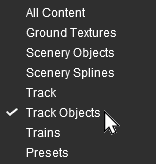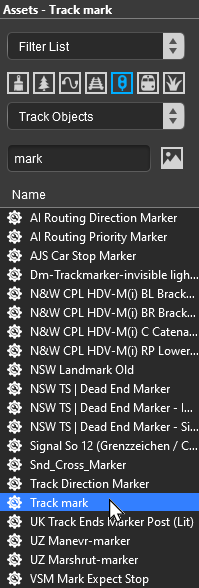How to Use S20 Tools
(→Narrowing the Search) |
(→Narrowing the Search) |
||
| Line 889: | Line 889: | ||
[[image:AssetsPalette_S20.png|link=|alt=Assets palette]]<br> | [[image:AssetsPalette_S20.png|link=|alt=Assets palette]]<br> | ||
| − | The | + | The drop down box will provide three options:-<br> |
<table width=350> | <table width=350> | ||
| Line 902: | Line 902: | ||
</table> | </table> | ||
<br> | <br> | ||
| − | These | + | These options work with the '''Asset Filters''' to help narrow the search for a specific asset or type of asset that is in the route.<br> |
<table width=900 bgcolor=#000000> | <table width=900 bgcolor=#000000> | ||
| Line 918: | Line 918: | ||
<tr valign="top"> | <tr valign="top"> | ||
<td><span style="font-weight: 700; font-size: 15ps; color: white; background-color: black;"> Filter Visibility </span></td> | <td><span style="font-weight: 700; font-size: 15ps; color: white; background-color: black;"> Filter Visibility </span></td> | ||
| − | <td>this option will '''hide''' all assets that are not in the filtered list. The only exceptions are '''Ground Textures''' and '''Effect | + | <td>this option will '''hide''' all assets that are not in the filtered list. The only exceptions are '''Ground Textures''' and '''Effect Layers''' which will be visible but, unless they are also in the filtered list, cannot be selected.</td> |
</tr> | </tr> | ||
</table> | </table> | ||
| + | </td> | ||
| + | </tr> | ||
| + | </table> | ||
| + | |||
| + | For example. The following images show the progressive application of a '''Visibility Filter'''.<br> | ||
| + | |||
| + | <table width=1000> | ||
| + | <tr valign="top"> | ||
| + | <td>[[image:AssetFilterScene1_S20.png|link=]]</td> | ||
| + | <td>[[image:AssestFilteredScene1.png|link=]]</td> | ||
| + | <td>No filter has been applied.<br> | ||
| + | <br> | ||
| + | All the assets are visible on the Surveyor screen.<br> | ||
| + | <br> | ||
| + | '''ALL''' assets can be selected by the '''Eyedropper Tool''' | ||
| + | </td> | ||
| + | </tr> | ||
| + | <tr valign="top"> | ||
| + | <td>[[image:AssetFilterScene2_S20.png|link=]]</td> | ||
| + | <td>[[image:AssestFilteredScene2.png|link=]]</td> | ||
| + | <td>The '''Visibility Filter''' option has been applied and the filtered list has been set to display only '''Scenery Splines'''.<br> | ||
| + | <br> | ||
| + | All assets except '''Scenery Splines''', '''Ground Textures''' and '''Effect Layers''' are now hidden.<br> | ||
| + | <br> | ||
| + | Only '''Scenery Splines''' can be selected by the '''Eyedropper Tool'''. | ||
| + | </td> | ||
| + | </tr> | ||
| + | <tr valign="top"> | ||
| + | <td>[[image:AssetFilterScene3_S20.png|link=]]</td> | ||
| + | <td>[[image:AssestFilteredScene3.png|link=]]</td> | ||
| + | <td>An additional filter has been applied. The word "fence" has been added to the search text box.<br> | ||
| + | <br> | ||
| + | All '''Scenery Splines''' that do not have the text "fence" in their names have now been hidden.<br> | ||
| + | <br> | ||
| + | Only the remaining visible splines, those with the text "fence" in their names, can be selected by the '''Eyedropper Tool'''. | ||
</td> | </td> | ||
</tr> | </tr> | ||
Revision as of 20:56, 8 January 2023
The information in this Wiki Page applies to Surveyor 2.0 (S20) as found in Trainz Plus.
This document is under development
|
|
|||||||||
The Tools Palette
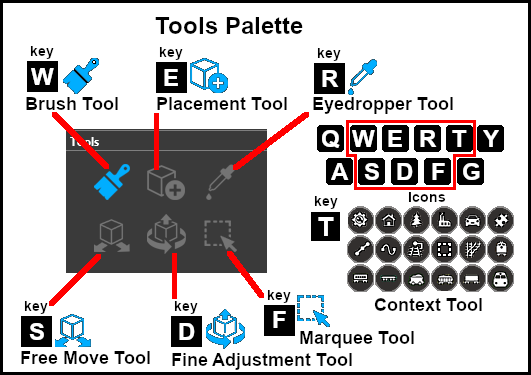 |
|
|||||||||||||||||
The Brush Tool
The Brush Tool is used for painting the route. It can:-
When selected, the Brush Tool will show two drop down menu lists. |
 |
| The first drop down menu will set the Brush Target, the type of brush. The Targets are:- |
|||||
|
 |
|
|||
Ground Height
This brush tool uses the Tools Options Palette. If this palette is not visible on the screen then refer to Notes: Palettes at the top of this document.
| When the Ground Height Target is selected, the second drop down box will give a choice of several Ground Height tools. The choices are:- |
|
|
 |
| The available brush tool options are shown in the Tools Options Palette with a Gold coloured icon next to their names. Those options that have their icon greyed out will be ignored, but they can still be edited. | ||||||||||||||||||||||||||||||||||||
Height Up/Height Down  |
Set Height  |
Grade 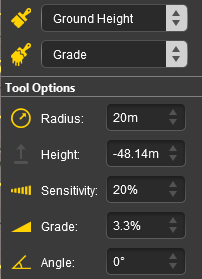 |
|
|||||||||||||||||||||||||||||||||
|
Ground Texture
This brush tool uses the Tools Options Palette. If this palette is not visible on the screen then refer to Notes: Palettes at the top of this document.
When the Ground Texture Target is selected, the second drop down box will be disabled - there are no brush texture tool choices.
The available brush tool options are shown in the Tools Options Palette with a Gold coloured icon next to their names. Those options that have their icon greyed out will be ignored, but they can still be edited.
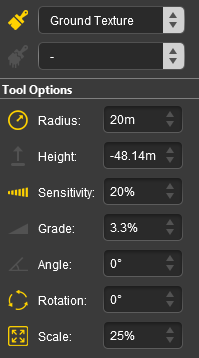 |
|
||||||||||||||||||||||||||||
|
Scrapbook Data
This brush tool uses both the Tools Options Palette and the Scrapbook Palette. If these palettes are not visible on the screen then refer to Notes: Palettes at the top of this document.
| The Scrapbook Brush When the Scrapbook Data Target is selected, the second drop down box will give a choice of two Scrapbook Data tools. |
|
|
|
|
| The available brush tool options are shown in the Tools Options Palette with a Gold coloured icon next to their names. Those options that have their icon greyed out will be ignored, but they can still be edited. | |||||||||||||||||||||||||||||||
Scrapbook Brush  |
Scrapbook Clone  |
|
|||||||||||||||||||||||||||||
|
The Scrapbook Palette 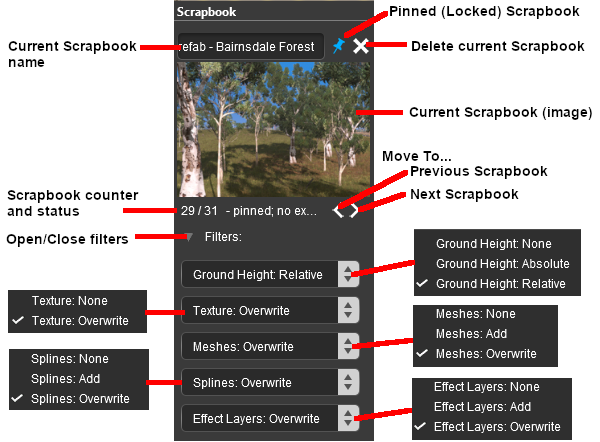 |
|
|||||||||||||||||||||||||||||||||||||||||||
Edit Effect Layers...
When this Target is selected, the Edit Effect Layers options will appear. This is the same as selecting Edit Effect Layers ... from the Trainz Edit Menu.
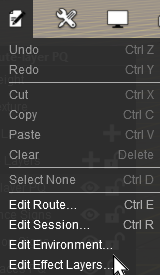 |
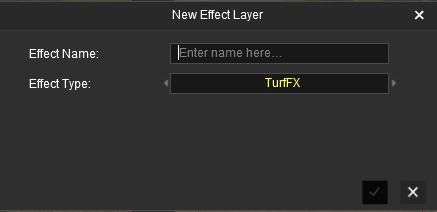 |
 |
 |
More information on creating and editing Effect Layers can be found on the Trainz Wiki at:- |
The Placement Tool
| Keyboard Shortcut: E |
The Placement Tool is used to add assets to the route.
This tool uses the Assets Palette. If this palette is not visible on the screen then refer to Notes: Palettes at the top of this document.
The first step is to identify and select the particular asset that you want to add to the route.
In the Asset Palette either:-
|
OR |
|
|
To narrow down the filter list type part of the asset name into the Search Text Box. For example if you have selected Track Objects and want to find "Trackmarks", then type "mark" (UPPER/lower case does not matter).
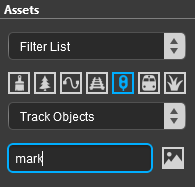 |
|
|
|
|
The Eyedropper Tool
| Keyboard Shortcut: R |
The Eyedropper Tool is used to identify objects that are in the route. The objects can be textures, effect layers, scenery, rolling stock, track. track equipment, and splines.
This tool uses the Assets Palette. If this palette is not visible on the screen then refer to Notes: Palettes at the top of this document.
Quick Steps
With the Eyedropper Tool selected, move the mouse pointer (which will now be an eyedropper symbol) onto any object in view.
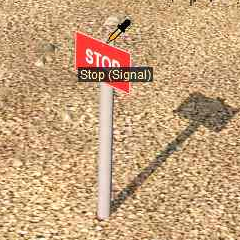 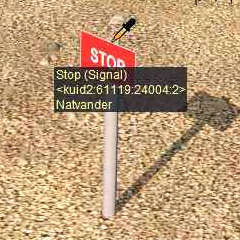 |
The object will be identified by its asset name appearing in a ToolTip below the mouse pointer (image shown left).
|
Narrowing the Search
Sometimes (or often) a scene will be too crowded with different scenery assets to be able to use the Eyedropper Tool to easily select a single object. In these cases additional options are available to help "remove the clutter".
At the top of the Assets Palette is a drop down box which controls how the Eyedropper Tool works with the filters that you set.
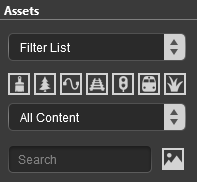
The drop down box will provide three options:-
|
 |
These options work with the Asset Filters to help narrow the search for a specific asset or type of asset that is in the route.
|
For example. The following images show the progressive application of a Visibility Filter.
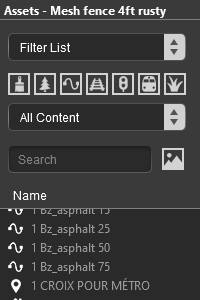 |
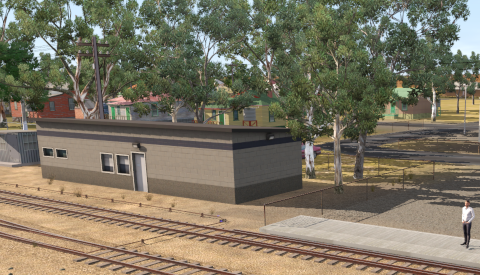 |
No filter has been applied.
|
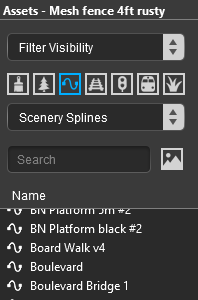 |
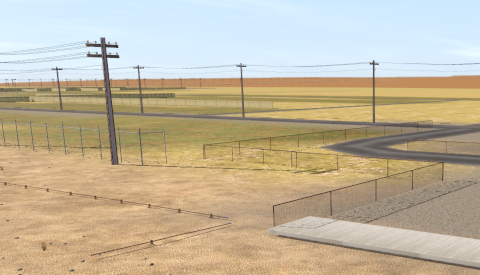 |
The Visibility Filter option has been applied and the filtered list has been set to display only Scenery Splines.
|
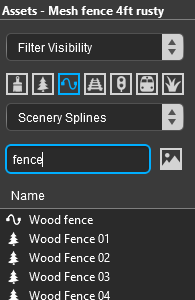 |
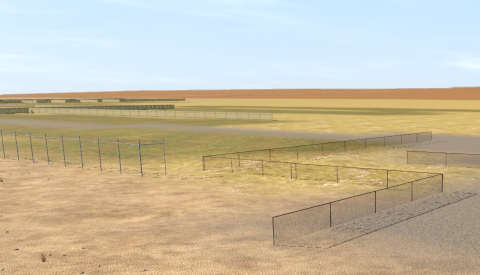 |
An additional filter has been applied. The word "fence" has been added to the search text box.
|
The Free Move Tool
| Keyboard Shortcut: S |
The Free Move Tool is used to move objects in the route.
The Fine Adjustment Tool
| Keyboard Shortcut: D |
The Fine Adjustment Tool is used to make fine adjustments (XYZ axis, rotation, tilt) to objects in the route.
The Marquee Tool
| Keyboard Shortcut: F |
The Marquee Tool is used to select areas of the route.
Trainz Wiki
 |
More Tutorials and Guides to Using Trainz |
This page was created by Trainz user pware in January 2023 and was last updated as shown below.



